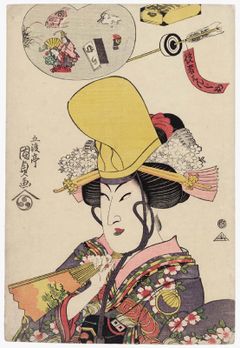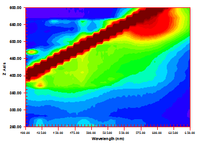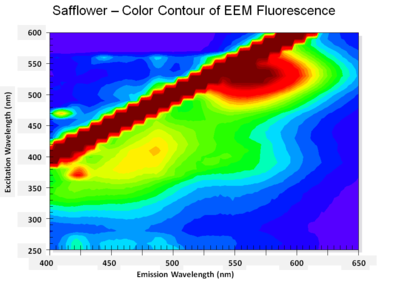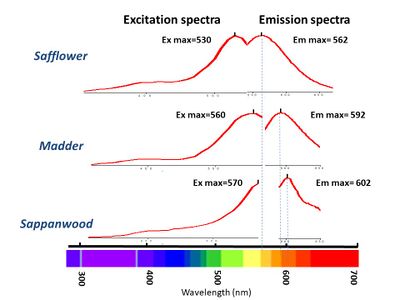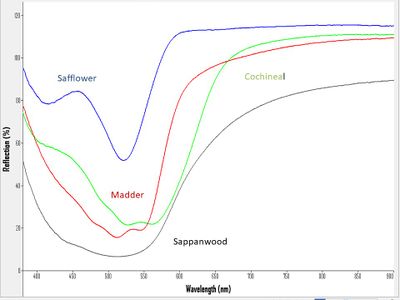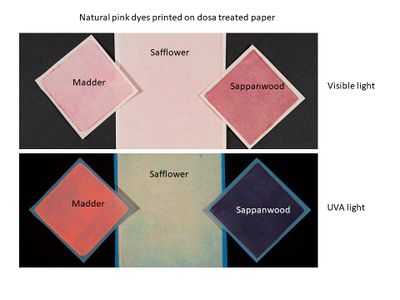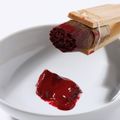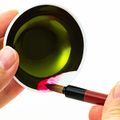Difference between revisions of "Category:Safflower: Ukiyo-e colorant"
| (46 intermediate revisions by 2 users not shown) | |||
| Line 1: | Line 1: | ||
| − | |||
| − | |||
| − | [[ | + | [[File:SC323786.jpg|right|240px|link=Kunisada, Actor Sawamura Tanosuke II, from the series Actor Rebuses, 11.42324|Actor Sawamura Tanosuke II by Utagawa Kunisada]] |
| − | + | <font size="3">'''[[Safflower]]'''</font> 紅花(''benibana''): An organic red obtained from the florets of ''Carthamus tinctorius'', it produces a range of tone from pink to red. The florets are picked, washed, massaged, and fermented to create safflower cakes (紅餅 ''beni mochi'') from which the red dye can be extracted later. Dried florets can also be used to extract the dye which are first washed with water to remove the non-lightfast yellow chromophors including several quinochalcones. The red colorant, primarily carthamin, is then extracted in an alkaline bath. Safflower was grown throughout Japan during the Edo period for use as cosmetics as well as food dyes. The area of Yamagata was known as a producer of high quality benibana and still produces it today. | |
| − | + | Safflower can be a light pink, such as the delicate pink used to depict the subtle eye shadow or blush to a deeper red. Safflower was noted to be expensive and require multiple printing to achieve a darker color. Safflower and [[:Category:Madder: Ukiyo-e colorant|madder]] are the most commonly found red before the introduction of aniline dyes. Red safflower and madder are found as a single colorant or as a mixture of the two. Although a visual difference between a single colorant red safflower and red safflower/madder mixture is hard to discern currently, madder may have been mixed to extend the safflower. Safflower is also most commonly used with [[:Category:Dayflower: Ukiyo-e colorant|dayflower]] to produce purple. This combination of safflower and dayflower is continuously detected even after the introduction of synthetic colorants such as [[:Category:Prussian Blue: Ukiyo-e colorant|Prussian blue]] and aniline dyes, which seems to indicate that the tone obtained by the two was preferred over other possible mixtures of reds and blues. | |
| − | + | '''For more information see:''' [[Safflower]], [[Safflower (Carthamus tinctorius) LC]] | |
| + | <br> | ||
| − | {|class="wikitable" style="display: inline-table;font-size:90%;text-align:center;width:15%" | + | == Examples of Safflower in Ukiyo-e Prints == |
| − | |[[File:Safflower red | + | |
| + | {| class="wikitable" style="display: inline-table;font-size:90%;text-align:center;width:15%" | ||
| + | |[[File:test-safflower1.png|200px|link=Kunisada, Actor Sawamura Tanosuke II, from the series Actor Rebuses, 11.42324]] | ||
| + | |- | ||
| + | | | ||
| + | [[File:Safflower red 06.809 EEM.png|200px]]<br>[[Kunisada, Actor Sawamura Tanosuke II, from the series Actor Rebuses, 11.42324|Actor Sawamura Tanosuke II... by Torii Kunisada]] | ||
| + | |} | ||
| + | {| class="wikitable" style="display: inline-table;font-size:90%;text-align:center;width:15%" | ||
| + | |[[File:dyed indigo.jpg|200px|link=Kiyomasu II, Actor Ogino Izaburô I as Yamagami Gennai, Acting in the Aragoto Style with the Sumikazura Wig, 11.13297]] | ||
|- | |- | ||
| | | | ||
| − | [[File: | + | [[File:Indigo FORS.JPG|200px]]<br>[[Kiyomasu II, Actor Ogino Izaburô I as Yamagami Gennai, Acting in the Aragoto Style with the Sumikazura Wig, 11.13297|Actor Ogino Izaburo I... by Torii Kiyomasu]] |
|} | |} | ||
{| class="wikitable" style="display: inline-table;font-size:90%;text-align:center;width:15%" | {| class="wikitable" style="display: inline-table;font-size:90%;text-align:center;width:15%" | ||
| − | |[[File:dyed indigo.jpg|200px]] | + | |[[File:dyed indigo.jpg|200px|link=Toyonobu, Rain in the Fifth Month, 11.19048]] |
|- | |- | ||
| | | | ||
| − | [[File:Indigo FORS.JPG|200px]]<br>[[ | + | [[File:Indigo FORS.JPG|200px]]<br>[[Toyonobu, Rain in the Fifth Month, 11.19048|Rain in the Fifth Month by Ishikawa Toyonobu]] |
|} | |} | ||
{| class="wikitable" style="display: inline-table;font-size:90%;text-align:center;width:15%" | {| class="wikitable" style="display: inline-table;font-size:90%;text-align:center;width:15%" | ||
| − | |[[File:dyed indigo.jpg|200px]] | + | |[[File:dyed indigo.jpg|200px|link=Harunobu, Nishikigi of the Kanaya Lighting Incense beside a Mosquito Net, 11.16479]] |
|- | |- | ||
| | | | ||
| − | [[File:Indigo FORS.JPG|200px]]<br>[[Harunobu, | + | [[File:Indigo FORS.JPG|200px]]<br>[[Harunobu, Nishikigi of the Kanaya Lighting Incense beside a Mosquito Net, 11.16479|Nishikigi of the Kanaya... by Suzuki Harunobu]] |
|} | |} | ||
{| class="wikitable" style="display: inline-table;font-size:90%;text-align:center;width:15%" | {| class="wikitable" style="display: inline-table;font-size:90%;text-align:center;width:15%" | ||
| − | |[[File:dyed indigo.jpg|200px]] | + | |[[File:dyed indigo.jpg|200px|link=Shunko, Actors Ichikawa Danjûrô V as Fukurokuju, Iwai Hanshirô IV as Ryûyô Dôji, and Sawamura Sôjûrô III as Shin'yô Dôji, 11.14971]] |
|- | |- | ||
| | | | ||
| − | [[File:Indigo FORS.JPG|200px]]<br>[[ | + | [[File:Indigo FORS.JPG|200px]]<br>[[Shunko, Actors Ichikawa Danjûrô V as Fukurokuju, Iwai Hanshirô IV as Ryûyô Dôji, and Sawamura Sôjûrô III as Shin'yô Dôji, 11.14971|Actors Ichikawa Danjûrô V... by Katsukawa Shunko]] |
|} | |} | ||
{| class="wikitable" style="display: inline-table;font-size:90%;text-align:center;width:15%" | {| class="wikitable" style="display: inline-table;font-size:90%;text-align:center;width:15%" | ||
| − | |[[File:dyed indigo.jpg|200px]] | + | |[[File:dyed indigo.jpg|200px|link=Eisen, Seijûrô and Onatsu; Banners of Bishamonten; from the series Amusements on the Festival Day, 11.17904]] |
|- | |- | ||
| | | | ||
| − | [[File:Indigo FORS.JPG|200px]]<br>[[ | + | [[File:Indigo FORS.JPG|200px]]<br>[[Eisen, Seijûrô and Onatsu; Banners of Bishamonten; from the series Amusements on the Festival Day, 11.17904|Seijûrô and Onatsu... by Keisai Eisen]] |
|} | |} | ||
== Analysis == | == Analysis == | ||
| − | + | Excitation Emission Matrix (EEM) spectroscopy can easily identify the organic reds: safflower, [[:Category:Madder: Ukiyo-e colorant|madder]], and [[:Category:Sappanwood: Ukiyo-e colorant|sappanwood]]. Safflower fluoresces under UVA radiation and produces a unique EEM plot, even when the safflower has visually faded to a dull brownish red. In addition to the fluorescence for the red chromophor, the pattern often contained an additional peak for the yellow chromophore that was supposedly removed in the preparation of the red colorant but often needed several washings for complete elimination. | |
| − | <gallery mode=packed heights=200px style="text-align:left"> | + | |
| − | + | ||
| − | + | <gallery mode="packed" heights="200px" style="text-align: left"> | |
| − | + | Safflower color.PNG|<center>3D EEM plot for Safflower</center> | |
| + | Red EEM plots.jpg|<center>3D EEM plots for Red references</center> | ||
| + | Red EmEx curves.jpg|<center>Overlay of EEM curves for Red references</center> | ||
| + | FORS of reds.jpg|<center>Overlay of FORS spectra for Red references</center> | ||
| + | Red UVVis images.jpg|<center>Visible light and UVA for Red references</center> | ||
</gallery> | </gallery> | ||
| + | |||
==Other Images of Safflower == | ==Other Images of Safflower == | ||
| Line 53: | Line 65: | ||
Safflower_plant.jpg |Safflower plant (''Carthamus tinctorius'') | Safflower_plant.jpg |Safflower plant (''Carthamus tinctorius'') | ||
safflower_raw_1.jpg|thumb|Safflower petals | safflower_raw_1.jpg|thumb|Safflower petals | ||
| − | + | 05 Safflower_petal cakes.jpg|Safflower cakes | |
| − | + | beni_safflower.jpg|Paper dyed with safflower | |
| + | saikubeni.jpg|Safflower colorant, <small>by Isehan Honten</small> | ||
| + | Cosmetic beni.jpg|Cosmetic beni (Rouge), <small>by Isehan Honten</small> | ||
</gallery> | </gallery> | ||
| − | == Examples == | + | ==List of Prints == |
| − | < | + | List of prints where safflower was detected |
| + | |||
| + | <!-- | ||
| + | == Examples of Safflower in Ukiyo-e Prints == | ||
| + | |||
| + | {|class="wikitable" style="display: inline-table;font-size:90%;text-align:center;width:15%" | ||
| + | |[[File:Safflower red lantern 06.809.png|200px|Red lantern (MFA 06.809)]] | ||
| + | |- | ||
| + | | | ||
| + | [[File:Safflower red 06.809 EEM.png|200px]]<br>[[EEM of red lantern in MFA 06.809]] | ||
| + | |} | ||
| + | {| class="wikitable" style="display: inline-table;font-size:90%;text-align:center;width:15%" | ||
| + | |[[File:Safflower pink 06.795.png|200px|Pink tree (MFA 06.795)]] | ||
| + | |- | ||
| + | | | ||
| + | [[File:Safflower pink 06.795 EEM.png|200px]]<br>[[EEM of pink tree in MFA 06.795]] | ||
| + | |} | ||
| + | {| class="wikitable" style="display: inline-table;font-size:90%;text-align:center;width:15%" | ||
| + | |[[File:Safflower light pink cloud 11.17586.png|200px]] | ||
| + | |- | ||
| + | | | ||
| + | [[File:Safflower light pink 11.17586 EEM.png|200px]]<br>[[EEM of pink cloud (MFA 11.17586)]] | ||
| + | |} | ||
| + | {| class="wikitable" style="display: inline-table;font-size:90%;text-align:center;width:15%" | ||
| + | |[[File:dyed indigo.jpg|200px]] | ||
| + | |- | ||
| + | | | ||
| + | [[File:Indigo FORS.JPG|200px]]<br>[[Harunobu, Beautiful Women of the Yoshiwara, Applying makeup (MFA 2006.1537.5)|Beauties of the Yoshiwara by Suzuki Harunobu]] | ||
| + | |} | ||
| + | {| class="wikitable" style="display: inline-table;font-size:90%;text-align:center;width:15%" | ||
| + | |[[File:dyed indigo.jpg|200px]] | ||
| + | |- | ||
| + | | | ||
| + | [[File:Indigo FORS.JPG|200px]]<br>[[Harunobu, Beautiful Women of the Yoshiwara, Applying makeup (MFA 2006.1537.5)|Beauties of the Yoshiwara by Suzuki Harunobu]] | ||
| + | |} | ||
| − | |||
| − | |||
| − | |||
| − | |||
| − | |||
| − | |||
| − | |||
| − | |||
| − | |||
| − | |||
| − | |||
<gallery> | <gallery> | ||
Safflower over turmeric 21.9230.png|Orange house (MFA 21.9230) with safflower and turmeric | Safflower over turmeric 21.9230.png|Orange house (MFA 21.9230) with safflower and turmeric | ||
Safflower over turmeric 21.9230 EEM.png|EEM | Safflower over turmeric 21.9230 EEM.png|EEM | ||
| − | + | ||
Safflower over turmeric 21.9230 XRF.png|XRF | Safflower over turmeric 21.9230 XRF.png|XRF | ||
</gallery> | </gallery> | ||
| Line 107: | Line 144: | ||
</gallery> | </gallery> | ||
| − | + | --> | |
Revision as of 13:15, 2 July 2020
Safflower 紅花(benibana): An organic red obtained from the florets of Carthamus tinctorius, it produces a range of tone from pink to red. The florets are picked, washed, massaged, and fermented to create safflower cakes (紅餅 beni mochi) from which the red dye can be extracted later. Dried florets can also be used to extract the dye which are first washed with water to remove the non-lightfast yellow chromophors including several quinochalcones. The red colorant, primarily carthamin, is then extracted in an alkaline bath. Safflower was grown throughout Japan during the Edo period for use as cosmetics as well as food dyes. The area of Yamagata was known as a producer of high quality benibana and still produces it today.
Safflower can be a light pink, such as the delicate pink used to depict the subtle eye shadow or blush to a deeper red. Safflower was noted to be expensive and require multiple printing to achieve a darker color. Safflower and madder are the most commonly found red before the introduction of aniline dyes. Red safflower and madder are found as a single colorant or as a mixture of the two. Although a visual difference between a single colorant red safflower and red safflower/madder mixture is hard to discern currently, madder may have been mixed to extend the safflower. Safflower is also most commonly used with dayflower to produce purple. This combination of safflower and dayflower is continuously detected even after the introduction of synthetic colorants such as Prussian blue and aniline dyes, which seems to indicate that the tone obtained by the two was preferred over other possible mixtures of reds and blues.
For more information see: Safflower, Safflower (Carthamus tinctorius) LC
Examples of Safflower in Ukiyo-e Prints

|

|

|

|

|

|
Analysis
Excitation Emission Matrix (EEM) spectroscopy can easily identify the organic reds: safflower, madder, and sappanwood. Safflower fluoresces under UVA radiation and produces a unique EEM plot, even when the safflower has visually faded to a dull brownish red. In addition to the fluorescence for the red chromophor, the pattern often contained an additional peak for the yellow chromophore that was supposedly removed in the preparation of the red colorant but often needed several washings for complete elimination.
Other Images of Safflower
List of Prints
List of prints where safflower was detected
Pages in category "Safflower: Ukiyo-e colorant"
The following 55 pages are in this category, out of 55 total.
E
- Eisen, Early Winter: The Day of the Boar in the Tenth Month, from the series Customs of the Four Seasons and Children at Play, 11.25587
- Eisen, Fujieda: Kichô of the Owariya, from the series A Tôkaidô Board Game of Courtesans: Fifty-three Pairings in the Yoshiwara, 11.17946
- Eisen, Seijûrô and Onatsu; Banners of Bishamonten; from the series Amusements on the Festival Day, 11.17904
- Eisen, The Song Evening Mist at Asama Peak, on Scrap-paper Fabric with an Itchû-bushi Libretto, from the series A Modern Pine Needle Collection, 11.17878
- Eishi, Shizuka of the Shizutamaya, from the series Beauties of the Yoshiwara as Six Floral Immortals, 21.4917
- Eishi, Shizuka of the Shizutamaya, from the series Beauties of the Yoshiwara as Six Floral Immortals, 53.21
- Eizan, Kashiku of the Tsuruya, from the series Array of Beauties of the Pleasure Quarters, 11.17716
H
- Harunobu, A Young Woman in a Summer Shower, 11.19430
- Harunobu, Beautiful Women of the Yoshiwara, Combing hair (2006.1537.1)
- Harunobu, Courtesan and Kamuro Looking at the Face of a Komusô Reflected in a Mirror, 45.833
- Harunobu, Courtesan Reading a Letter by Moonlight Reflected on Snow; Parody of Son Kang, 11.19438
- Harunobu, Courtesan Riding a Carp and Reading a Letter; Parody of the Immortal Qin Gao, 06.969
- Harunobu, Kojima Bingo no Saburô Takanori, 11.19633
- Harunobu, Nishikigi of the Kanaya Lighting Incense beside a Mosquito Net, 11.16479
- Harunobu, Parody of Saigyô Hôshi: Courtesan Looking at a Screen Painting of Mount Fuji, 11.19431
- Harunobu, Poem by Saigyô Hôshi, from an untitled series of Three Evening Poems, 34.348
- Harunobu, The Sake Cup, sheet 4 of the series Marriage in Brocade Prints, the Carriage of the Virtuous Woman, known as the Marriage series, 11.19475
K
- Kiyohiro, Two Children Playing with Hobbyhorses, 11.19047
- Kiyomasu II, Actor Ogino Izaburô I as Yamagami Gennai, Acting in the Aragoto Style with the Sumikazura Wig, 11.13297
- Kiyomasu II, Actors Segawa Kikunojô I as Ochiyo; Matsushima Kichisaburô as Ochiyo's Spirit Projection, the Courtesan Tekkai Sennin; and Ichikawa Ebizô II as Mushanosuke of Ôsaka, 21.5452
- Kiyomitsu I, Actor Segawa Kikunojô II as Itsuki, 11.19020
- Kiyomitsu I, Actor Segawa Kikunojô II as Seryômura Okiku, 11.18992
- Kiyomitsu I, Actors Segawa Kikunojô II as the Courtesan Katsuragi and Ichimura Uzaemon IX as Nagoya Sanza, 45.832
- Kiyomitsu I, Actors Ôtani Hiroji III as Okabe no Rokuyata and Nakamura Sukegorô II as Inomata no Koheiroku, 46.1409
- Kiyomitsu I, Yoritomo's Hunt at the Foot of Mount Fuji, 11.19694
- Kiyonaga, A Matchmaking Meeting at a Teahouse by a Shrine, 21.5574
- Kiyonaga, Actors Matsumoto Kôshirô IV as Ukita Sakingo and Sawamura Sôjûrô III as the Ghost of Takao, with chanters Tomimoto Itsukidayû and Tomimoto Awatayû, and accompanist Sasaki Ichishirô, 11.13921
- Kiyonaga, Actors Matsumoto Kôshirô IV as Ukita Sakingo and Sawamura Sôjûrô III as the Ghost of Takao, with chanters Tomimoto Itsukidayû and Tomimoto Awatayû, and accompanist Sasaki Ichishirô, 21.5476
- Kiyonaga, Child Prodigy Minamoto no Shigeyuki Executing Calligraphy, 11.13883
- Kiyonaga, Women Visiting Enoshima, 11.21277
- Koryusai, Descending Geese at Mimeguri, from the series Fashionable Eight Views of Edo, 11.14627
- Kunisada, Actor Sawamura Tanosuke II, from the series Actor Rebuses, 11.42324
- Kuniyoshi, (Actor Ichikawa Ebizô V as) Inuyama Dôsetsu, from the series The Lives of Eight Brave and Loyal Dog Heroes, 11.28841
- Kuniyoshi, Hosokute: Horikoshi Dairyô, from the series Sixty-nine Stations of the Kisokaidô Road, 11.28766
M
S
- Kiyonobu I, Actor Ôtani Hiroji I as the Candy-seller Kokusen-ya, 11.13165
- Kiyotada I, Actors Sanjô Kantarô II and Ichimura Takenojô IV, 11.13273
- Sharaku, Actors Ichikawa Komazô III as Kameya Chûbei and Nakayama Tomisaburô I as Umegawa, 21.7236
- Shigenobu I, Urashima Tarô, from the series A Set of Five Examples of Longevity, 21.9254
- Shinsai, Chapters 22–24, from the series The Tale of Genji, 11.20034
- Shunkō, Actors Ichikawa Danjûrô V as Fukurokuju, Iwai Hanshirô IV as Ryûyô Dôji, and Sawamura Sôjûrô III as Shin'yô Dôji, 11.14971
- Shunkō, Actors Nakamura Nakazô I and Ôtani Hiroji III, 11.2014
- Shunman, Mandarin Ducks and Iris, from the series Series of Seven Bird-and-Flower Prints for the Fuyô Circle of Kanuma in Shimotsuke Province, 21.9226
- Shunshō, Actor Segawa Kikunojô III as Shirokiya Okoma, from the series Fans of the East, 11.14871
T
- TEST-Utamaro I, Women Overnight Guests, a Triptych, 21.6328-30
- TEST-Utamaro I, Women Overnight Guests, left panel of triptych, 21.6328
- Toyokuni, Actor Arashi Kitsusaburô I as the Monkey Trainer Yojirô, in the Horikawa Scene of the Play Oshun and Denbei, 11.30331
- Toyonobu, Rain in the Fifth Month, 11.19048
- Toyonobu, Young Couple Burning Maple Leaves to Heat Sake, 11.19676
U
- Utamaro I, A Yoshiwara Triptych, 11.14191
- Utamaro I, Courtesan Asajiu of the Daimonjiya and Nanatsu-ume Sake by Momenya, from the series Aristocrats of Sake Compared to Courtesans of Six Selected Houses, 11.14267
- Utamaro I, The Geisha Ogie Matsuzô, Mine, and Ito, 11.14373
- Utamaro I, The Heron Maiden from series An Array of Dancing Girls of the Present Day, 11.14364
